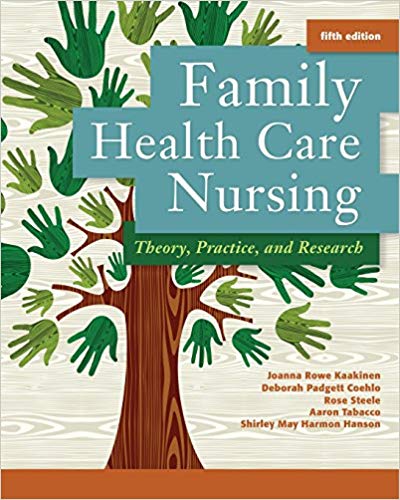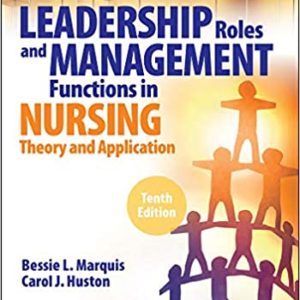Test Bank Family Health Care Nursing Theory Practice And Research 5th Edition By Rowe Kaakinen
$35
Description
Rowe Kaakinen, Family Health Care Nursing 5th edition Test Bank
Family Health Care Nursing: Theory, Practice, And Research 5th Edition Test Bank By Rowe Kaakinen, Joanna, Coehlo, Deborah Padgett
Which of the following statements is true about family nursing practice?
a. Family care is concerned with the experience of the family over time.
b. Family nursing is directed at families whose members are both healthy and ill.
c. The family nurse is responsible with the family itself for defining who is the family.
d. If family nursing practice is successful, the family members will simultaneously
achieve maximum health.
e. All of the above
2. Which of the following nursing specialties has historically focused on the quality of family
health?
a. Maternity nursing
b. Pediatric nursing
c. Public health nursing
d. All of the above
3. Family health care nursing is a specialty that started near the end of the 20th century.
a. True
b. False
4. The most appropriate time for the nurse to collaborate with a family regarding realistic and
culturally appropriate outcomes is before addressing interventions.
a. True
b. False
5. Select four traits that are common in healthy families.
a. Develops suspicion amongst membersRowe Kaakinen, Family Health Care Nursing, 5e 13
Instructor’s Guide
b. Exhibits a sense of shared responsibility
c. Admits to and seeks help with problems
d. Enforces participation in rituals and tradition
e. Shares leisure time
f. Updates each other through social media about daily happenings
g. Maintains unchangeable rules
h. Teaches respect for others
Reflection Questions
Note: All chapters of the instructor’s manual include reflective questions as means of evaluating
learning. A deep understanding of family requires more than simply choosing an answer in a
multiple-choice format. Reflective writing or in-depth thought about one’s assumptions, values,
and belief systems can result in both personal and professional growth for students and nurses
alike.
1. Describe the difference between family as a client and family as a system.
Answer: The family as a client centers on the assessment of all individual family
members where the family is in the foreground and individuals are in the
background. The family is the sum of individual family members with a focus on
each and every individual such as one may see in a family medical practice office.
The family as system views the family as an interactional system whereby the
interactions between family members become the target for nursing interventions.
The nurse focuses on the individual and family simultaneously. Rowe Kaakinen,
Family Health Care Nursing, 5e 14
Instructor’s Guide
2. Discuss three traditional functions families performed over history that still exist today.
What are two family functions that have become more meaningful in modern times?
Answer:
Families existed to achieve economic survival.
Families existed to reproduce the species.
Families existed to provide protection from hostile forces.
Families passed along the religious faith (culture).
Families educated their children (socialization).
Families conferred social status on their children.
In modern times, the building of relationships and health care function of
families have received more attention.
Student Learning Activities
1. Have students working in a clinical site ask their patients who is in their family, and
suggest including this information on the patient record.
2. In Chapter 1, family is defined as “two or more individuals who depend on one another
for emotional, physical, and economical support. The members of the family are self defined” (Kaakinen et al., 2010, p. 5). Have students discuss this definition in small
groups and then report back to the larger class how they feel about this definition versus
others (U.S. Census, each state, province, etc.) when applied to their own personal or
professional lives, or both.
Rowe Kaakinen, Family Health Care Nursing, 5e 15 Instructor’s Guide
3. List five traits that are common in healthy families. Give examples of how the family
nurse would assess these. Have students do an assessment on their own families
according to the criteria for healthy families found in the text (Box 1-1).
Answer: Answers from the following are acceptable: communicates and listens to
one another, affirms and supports one another, teaches respect for others,
develops a sense of trust in members, displays a sense of play and humor, exhibits
a sense of shared responsibility, teaches a sense of right and wrong, has a strong
sense of family in which rituals and traditions abound, has a balance of interaction
among members, has a shared religious core, respects the privacy of one another,
values service to others, fosters family table time and conversation, shares leisure
time, or admits to and seeks help with problems.
4. Have students learn how agencies in which they are assigned clinical experiences
define family. Have students interview nurses in assigned units to learn what kinds of
ethical dilemmas or legal considerations regarding family members the nurses have
faced in their practice.
5. Have students discuss the implications for nursing care when the agency’s definition of
family is not congruent with those of the patient or nurse, or both. Alternatively,
students may be able to describe and reflect on their own experiences as a student
nurse, depending on where they are at in their program of study.
6. Have students explore the history of families, choosing a specific topic to follow across
time. Topics of interest include child abuse, domestic violence, unwed mothers, women
and work, child labor, alcohol dependency, juvenile delinquency, and mental health
(particularly depression and suicide). This exercise emphasizes that contemporary
You must be logged in to post a review.



Reviews
There are no reviews yet.